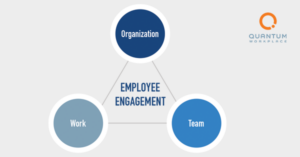By Michael Frye, MD and Jill Maraist
Improving clinician engagement is always a high priority, particularly now, when the health care industry is experiencing significant staffing turnover and shortages. Hospital administrators and medical directors must make creating an environment where clinicians can build long and satisfying careers an imperative.
A 2020 Harvard Business Review study (in association with Quantum Workplace, an employee engagement software company) found that 72 percent of business executives “strongly agree” that organizations with highly engaged employees have happy customers. Companies that invest in engagement solutions show:
- Improved employee productivity
- Better employee retention
- Greater customer satisfaction
The same holds for health care. Research shows that engaged health care workers equal better patient care.
According to MedicalGPS, employee engagement in medicine is one of the top characteristics that correlates with mortality, complications, job-related accidents, patient safety, clinical outcomes, staff turnover, and absenteeism.
Therein lies the problem: Clinicians are not engaged. Harvard Business Review reports that physicians have the “lowest engagement across the health care workforce,” citing three in five reports feeling disengaged.
What Is Employee Engagement?
It’s safe to assume many leaders think employee happiness and engagement are one and the same. In reality, they are very different. Here’s a workable definition:
Employee engagement is the level of connection between employees and their workplace.
Truly engaged clinicians have a deep emotional commitment to their organization and its goals. They genuinely care about their work, patients, and fellow team members.
Their motivation isn’t a paycheck, the next promotion, or some form of self-aggrandizement. They work on behalf of the organization’s goals, first and foremost. They stay aligned and connected to their work, the organization, and the team, as this graphic from Quantum Workplace illustrates:

Benefits of Having Engaged Clinicians
Engaged clinicians lead to better experiences for everyone in the hospital setting. It drives quality patient care, but it also helps improve financial performance.
According to Quantum Workplace, an engaged team yields many benefits:
- Lower job stress and improved job satisfaction – Employee “engagement” and “happiness” may be separate things, but happiness still counts.
- Decreased workplace injury – 70 percent fewer safety incidents occur in highly engaged workplaces.
- Better health – Engaged employees are less likely to be obese or suffer from chronic illness. They are also more likely to exercise and eat healthy.
- Higher retention – Engaged employees know employers will recognize their contributions, making them less inclined to leave.
- Increased productivity – Engaged employees are 17 percent more productive than their peers.
Those benefits have a direct bearing on patient satisfaction. Happier, more engaged clinicians exhibit genuine care toward patients they interact with — and patients take notice. That has a compounding effect, increasing patient loyalty and satisfaction.
Top Drivers of Clinician Engagement
None of this happens by accident. Improved clinician engagement results from a determined effort on the part of hospital leaders to foster a supportive culture. Here are five of the top clinician engagement drivers, along with relevant tips for improving engagement:
Leaders Who Listen
Leaders, listen to what your team is saying. Clinicians who don’t feel their opinions matter won’t work as hard or stay around as long as those who do. The burden falls on you to provide opportunities for feedback — regular surveys are helpful. Also, create strategies and solutions based on each person’s and team’s specific needs.
Proper Tools and Resources
Look for technology that streamlines communication, medical practice, and scheduling. Clinicians will appreciate your efforts to reduce the administrative burden with evidence-based processes.
Workplace Wellness
Make promoting a culture of wellness a high priority. Encourage work-life balance in scheduling and the environment. Inspire leaders to model a healthy balance as much as possible.
Recognition and Appreciation
Recognition can be a powerful motivator to increase engagement and reduce turnover. Find ways to celebrate your people and draw attention to excellence. Routinely check the pulse on how your team is doing and recognize when times are tough and when things are going well.
High Trust Environment
Your clinicians need to know they can count on you, so work to build trust and rapport with every team member through transparent collaboration and communication.
Conclusion
Fostering a high-engagement workplace environment can be challenging. With a bit of effort and encouragement on your part, engaged clinicians will go above and beyond the basic duties their jobs require.
Make engagement a strategy, not merely an activity. Analyze feedback, choose critical areas to focus on, brainstorm solutions, commit to making improvements, and communicate your progress.
Always keep your organization’s mission front and center. Set the tone, cast the vision, and do your best to get everyone on board.
When you channel your efforts and clinicians’ energy in the right direction, you will see clinician engagement bear fruit in several business-related outcomes.

